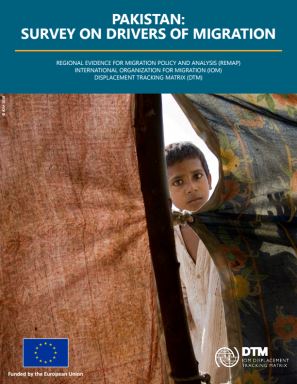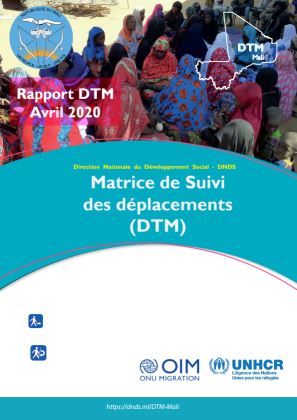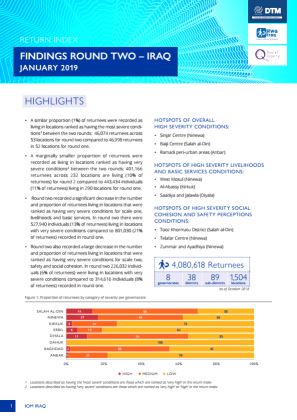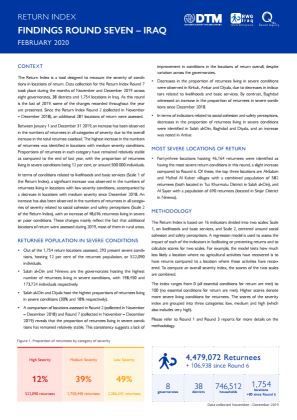-
Countries
-
Data and Analysis
-
Special Focus
-
Crisis Responses
Return Intention

Contact
DTM Yemen, iomyemendtm@iom.int
Language
English
Location
Yemen
Period Covered
May 31 2020
Jun 06 2020
Activity
- Return Intention
- Rapid Emergency Registration
- Mobility Tracking
Between 31 May and 6 June 2020, newly displaced households were recorded in Al Maharah (408HH), Shabwah (352HH), and Hadramaut (181HH). Most of these displacements were the result of natural disaster in Al Maharah (408HH), Shabwah (352HH), and for Aden (187 HH) as a result of COVID-19.

Contact
DTM REMAP Support Team, dtmremap@iom.int
Language
English
Location
Pakistan
Period Covered
Jan 01 2019
Dec 31 2019
Activity
- Survey
- Flow Monitoring Survey
- Return Intention
The key finding of this report is that motivations for Pakistani emigration revolve primarily around seeking better livelihood and income opportunities. This is reinforced by the historical relevance of labour migration out of Pakistan as well as previous data collection and analyses by IOM DTM. A secondary driver of migration for Pakistani migrants is the opportunity to continue or receive better quality education abroad. Finally, this report emphasizes the integral role of transnational social networks in influencing destination choice and migration decisions among Pakistani migrants.

Contact
DTM REMAP Support Team, dtmremap@iom.int
Language
English
Location
Afghanistan
Period Covered
Jan 01 2019
Dec 31 2019
Activity
- Survey
- Flow Monitoring Survey
- Return Intention
The key finding of this report is that push and pull factors, as well as the challenges Afghan potential migrants face daily at personal, household and community levels, revolve around a lack of livelihood options and insecurity. The lack of livelihood options and insecurity are mutually reinforcing – years of prolonged conflict has led to a lack of overall economic development and vice versa. The division of potential migrants along categories of, on the one hand, those fleeing insecurity, persecution and violence, and on the other, those migrating for economic reasons, cannot easily be maintained – both for individual cases, as well as a categorisation for those looking to leave Afghanistan. These insights have been consistent with previous research undertaken by DTM and others on the topic, mostly notably the CFMS (IOM (d), 2019; IOM (e), 2019; EASO, 2016). More research is needed to analyse different and changing migration routes, motivations, capabilities, financing, networks, regulatory frameworks and the role of smuggling networks and diaspora groups on the determinants of Afghan migration to Europe, both in countries of origin, transit and destination and for different segments of Afghan migrants – which is beyond the scope of the current research.

Contact
DTM Mali, DTMMali@iom.int
Language
French
Location
Mali
Period Covered
Apr 01 2020
Apr 30 2020
Activity
- Survey
- Return Intention
- Flow Monitoring
- Mobility Tracking
- Baseline Assessment
Les opérations de collecte et de mise à jour des données menées dans le cadre du programme DTM montrent une augmentation du nombre de personnes déplacées au Mali entre janvier et avril 2020. Le nombre de PDIs est en effet passé de 207 751 personnes (rapport CMP de décembre 2019) à 250 998 en avril 2020 soit une augmentation de 43 247 individus. Cette augmentation est due à des violences variées dans les Régions de Mopti, Ségou, Tombouctou, Gao et Ménaka et la bande frontalière Mali-Burkina FasoNiger. En effet, ces violences ont provoqué le déplacement de populations de leurs villages et hameaux pour trouver refuge dans les localités où la situation sécuritaire semble plus calme.

Contact
DTM Mozambique, DTMMozambique@iom.int
Language
English
Location
Mozambique
Period Covered
Mar 17 2020
Apr 03 2020
Activity
- Survey
- Return Intention
In March 2019, Cyclone Idai caused the destruction of housing and infrastructure and that left more than 400,000 people displaced, with 160,927 having immediately sought refuge in over 164 temporary accommodation centres. The cyclone contributed to significant housing damage, particularly in communities with poorly built houses. The most affected locations were Manica, Sofala, Tete and Zambezia provinces in central Mozambique. Since then, displaced populations have either returned to their places of origin, relocated to new areas or have settled in various resettlement sites which were set up across the central provinces.
Working alongside the Shelter Cluster and the Cabinet for Reconstruction (GREPOC), IOM's DTM team collaborated with Mozambique’s National Institute for Disaster Management (INGC) conducted an assessment of the shelter conditions of both displaced and non-displaced families across the four affected provinces, to gain a better understanding of the current housing conditions and the communities’ abilities to self-recover, as well as and the type of shelter and housing support still required to enable affected households to restore their lives.
This assessment was designed through a collaboration between DTM and the Shelter Cluster in Mozambique, and based on the guidance outlined in the Post-Cyclone Reconstruction Programme (PALPOC) developed by GREPOC, to guide the reconstruction efforts by partners. This collaboration ensured that the indicators would align with the PALPOC whilst maintaining DTM methodologies.
Findings from this assessment are presented according to settlement types, and include information on geographic location, demographic composition, displacement history, access to building materials, technical knowledge, housing conditions and the needs of both displaced and non-displaced families.

Contact
DTM Iraq, IraqDTM@iom.int
Language
English
Location
Iraq
Period Covered
Jan 01 2020
Feb 29 2020
Activity
- Survey
- Return Intention
- Mobility Tracking
- Baseline Assessment
The Return Index is a tool designed to measure the severity of conditions in locations of return. Data collection for the Return Index Round 8 took place during the months of January and February 2020 across eight governorates, 38 districts and 1,850 locations in Iraq. During Round 8, an additional 98 locations of return were assessed.

Contact
DTM Iraq, IraqDTM@iom.int
Language
English
Location
Iraq
Period Covered
Jul 01 2019
Aug 31 2019
Activity
- Survey
- Return Intention
- Mobility Tracking
- Baseline Assessment
Data collection for the Return Index Round 5 took place during the months of July and August 2019 across eight governorates, 38 districts and 1,634 locations in Iraq. Since the previous round (collected in March–April 2019), the number of
returnees has continued to increase and as of 31 August 2019, an additional 113,082 returnees were identified, reaching a total of 4,323,816 returnees (720,636 families). During Round 5, an additional 73 locations of return were assessed

Contact
DTM Iraq, IraqDTM@iom.int
Language
English
Location
Iraq
Period Covered
Oct 01 2018
Oct 31 2018
Activity
- Survey
- Return Intention
- Mobility Tracking
- Baseline Assessment
This second return index report builds on the ‘findings round one’ report released in 2018 and is a comparative analysis between this initial round of data collection and the latest round. The return index uses two sets of indicators on a) livelihoods and basic services and b) social cohesion and safety perceptions to create a severity score. The data for this report was collected in October 2018 in 1,504 locations across Iraq, that is, 77 more locations were assessed compared to round 1 and 233,048 additional returnees were recorded by DTM.

Contact
DTM Iraq, IraqDTM@iom.int
Language
English
Location
Iraq
Period Covered
Jan 01 2019
Dec 31 2019
Activity
- Survey
- Return Intention
- Mobility Tracking
- Baseline Assessment
The Return Index is a tool designed to measure the severity of conditions in locations of return. Data collection for the Return Index Round 7 took place during the months of November and December 2019 across eight governorates, 38 districts and 1,754 locations in Iraq. As this round is the last of 2019, some of the changes recorded throughout the year are presented. Since the Return Index Round 2 (collected in November – December 2018), an additional 281 locations of return were assessed. Between January 1 and December 31 2019, an increase has been observed in the numbers of returnees in all categories of severity due to the overall increase in the total returnee caseload. The highest increase in the numbers of returnees was identified in locations with medium severity conditions. Proportions of returnees in each category have remained relatively stable as compared to the end of last year, with the proportion of returnees living in severe conditions being 12 per cent, or around 500 000 individuals.

Contact
DTM Iraq, IraqDTM@iom.int
Language
English
Location
Iraq
Period Covered
Sep 01 2019
Oct 31 2019
Activity
- Survey
- Return Intention
- Mobility Tracking
- Baseline Assessment
The Return Index is a tool designed to measure the severity of conditions in locations of return. Data collection for the Return Index Round 6 took place during the months of September and October 2019 across eight governorates, 38 districts and 1,674 locations in Iraq. During Round 6, an additional 41 locations of return were assessed.
Pagination
- Previous page
- Page 26
- Next page
